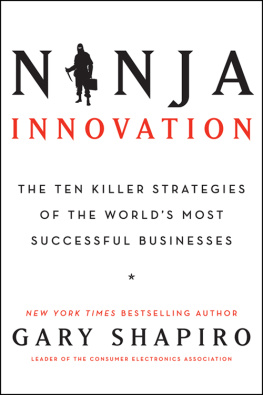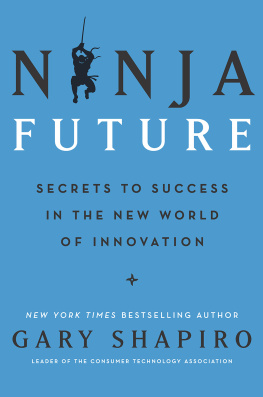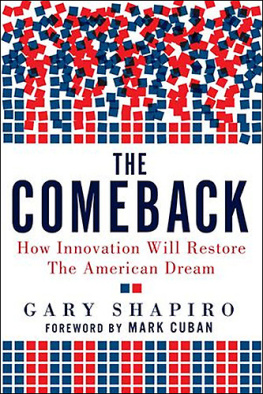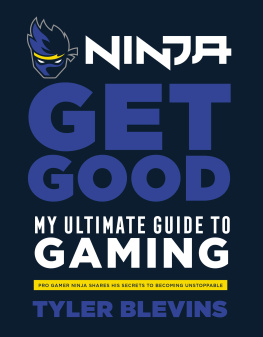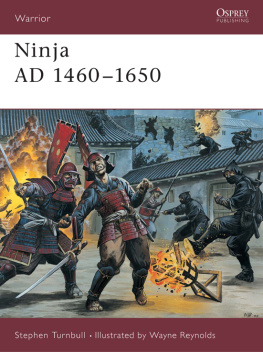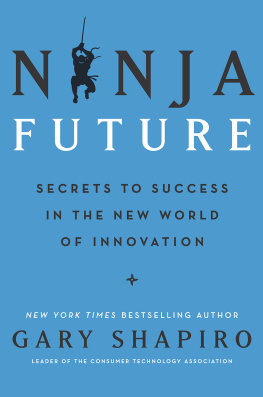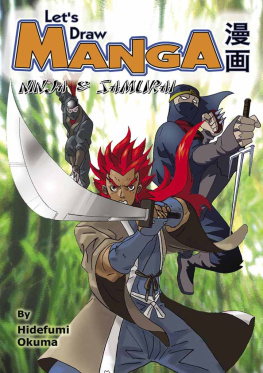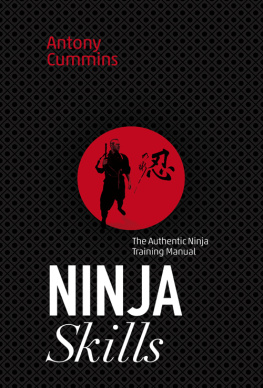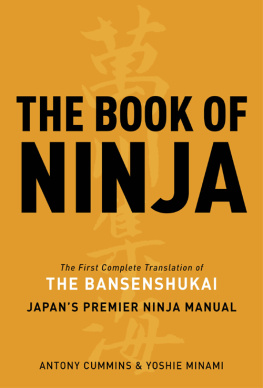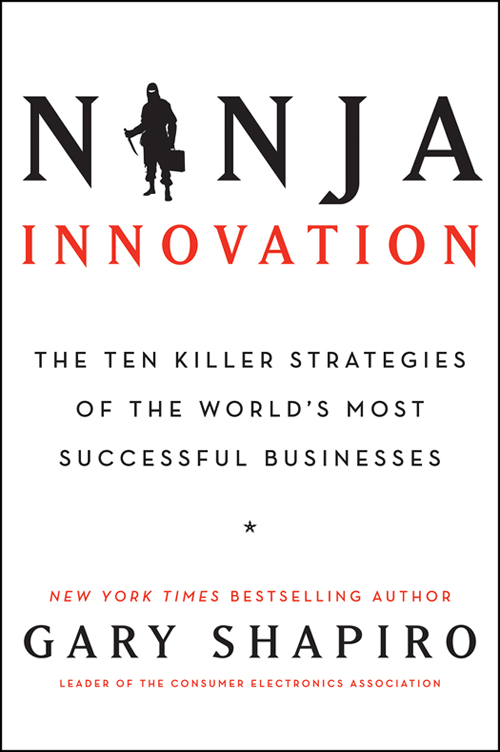

To my sons: Steve, Doug, Mark, and Max. Each wonderful... each different. This book is for them and their future children. Ninjas make things happen. And so will they!
Contents
MANY YEARS AGO I ACHIEVED MY BLACK BELT IN TAE KWON DO. THE accomplishment marked the end of a journey that had pushed me to the limits of my mental and physical abilities. The test for every belt on the ladder from yellow to black was an intensely exhausting experience. Your forms had to be perfect, your placements precise, and your discipline unwavering. And when you were finally finished, battered but proud of victory, it started all over again. There was always another kick to learn and another kata to master on the path to a higher belt. The test for the black belt, however, which signifies the repudiation of fear, far surpassed anything I could have imagined.
But my own test was nothing compared to the experience of watching my seven- and eight-year-old sons vie for their black belts. With my stomach in knots, I wanted to rush onto the mat and protect my boys during their sparring matches. But my then-wife and I held steady, because we knew that they were learning an important lesson: accomplishment requires sacrifice and risk.
While all of my family was fortunate enough to receive their black belts, I knew we were in the minority in the class. Many students dropped out after receiving a milestone belt. Others tested repeatedly for black belts but failed over and over. For most, the katas and skills proved too difficult. Sometimes, the board just wont break.
Along the way, I entered a few tournaments, which were scarier and riskier than I had imagined. Practice is one thing; doing it live is something else. But those were the only times I displayed my tae kwon do skills in combat. I have never had to use them in actual self-defense, nor have my sonsto my knowledge at least. This might lead some to wonder: Why would you go through all the personal anguish just for a few colored cotton belts? Good question.
Originally, I studied tae kwon do because I thought it would be a great experience to go through with my sons and then-wife. But as we progressed together, it hit me that this wasnt just about them. I was becoming a more focused, disciplined person. I am not by nature an idle guy, so I didnt need tae kwon do to rejuvenate my passion for work or family. What it did do was shape the way I approached my job; it put everything into a framework that I have since been able to rely on for decades.
If I had to define this framework, it would go something like this: to be successful, one must set goals; to achieve these goals, one must form a strategy; and to fully execute that strategy one must never let failures get in the way. Indeed, one must use those failures to get better. I learned this simple formula through my study of tae kwon do, and Ive continually applied it to my career long after hanging up my gi .
But theres another element to this framework that defies a simple definition. It is innovation. To be successful, one has to move beyond what has come before. One must take the lessons learned through study, experience, and failure, and apply them in ways that change the game, so to speak. You cannot be successful in tae kwon do if all you do is repeat what you are taught. A beginner white belt learns this early, when he or she must spar for the first time. Your competition wont play fair; it wont do what you expect; and it will always, always fight back. When youre on the mat, you must assume your competition knows what you know; that it too has a strategy for victory. The only way you can defeat your opponent is if you do something he does not expect; you must innovate or die.
This happens to also be the fundamental lesson I have learned from thirty years working and leading the most dynamic industry on the planet: the consumer electronics industry. You could measure our success through dollars and centsand indeed, these are impressive in their own right. But thats not how I measure our achievements. For me, as for all of our members, success is defined by reaching a previously insurmountable height. Whats been remarkable is that CE companies have done this again and again. The world that we live in today is unrecognizable to that of just twenty years ago. From smart phones and e-readers to HDTV and wireless broadband, from digital cameras and MP3 players to tablet computers and motion-detection gamingnothing is ever static; no product is ever immune to competition; and we can never tell where well be in five years. The simple reason: innovation.
Which is not to discount other highly successful companies in other industries, some of which I will discuss in the following pages. But my experience has been with consumer electronics and I have been fortunate to witness this industry develop into the colossus that it is today. And as Ive watched my industry rise, Ive seen some of the best business models ever devised. Ive also witnessed a fair share of pretty bad ones. Ive observed companies shine as bright as a shooting star, only to flame out just as quickly. Ive seen other companies rise and fall and rise again, like the proverbial phoenix. And then there are those companies whose only trajectory is ever upward, whose employees and products are part of the American tale.
Not so long ago it struck me that these stories were worth telling. Particularly during a time of economic uncertainty, where millions of Americans are out of work and pessimistic about our future, I realized there was a need to remember what made us into the greatest nation on earth. In 2011, I published The Comeback: How Innovation Will Restore the American Dream . In it, I laid out a strategy for the country that would not only put innovation at the heart of U.S. economic policy but also reinvigorate Americas great innovative spirit.
The Comeback outlines the fundamentals that can lead to economic success on a national scale. In other words, at a very high, stratospheric level. What about the individuals and enterprises on the ground whose collective actions have built America and will fuel our national resurgence? Surely, I thought, there are some lessons we can learn (or remember) from those who changed our lives in both good economic times and bad. After all, I must have some notion, considering that for thirty years I have worked in an industry whose successes and failures are the stuff of legend.
It was in analyzing that question that this present book came to be. The challenge was to find the common traits that connected these successes with one another. A book that simply documents successful companies without asking what made them so successful wasnt particularly interesting to me. Then I recalled my own framework for success and wondered if it would apply to the stories I wanted to tell. I learned my framework through the study of tae kwon dowhich, stripped to its core, is the study of how to be a warrior. But not just any warrior, rather a highly disciplined, strategic, and passionate warrior. In other words, a ninja.
In the following pages, I hope to explain better what I mean by the term ninja innovation . What do these ancient warriors of feudal Japan have to tell us about success in business? What can we learn from them that might help rejuvenate our passion for innovation? It is this connectionbetween the ancient ninja warrior and todays innovation warriorthat is the purpose of this book. It is the story of the entrepreneur who toils away at an idea; it is the story of a CEO who saves a company on the brink of collapse; it is the story of the enterprise that has everything going for it, yet fails anyway; it is the story of a corporation that time and again reinvents itself to stay dominant. What ties these tales together? What defines them? What separates them? What can we learn from the successes as well as the failures?
Next page
